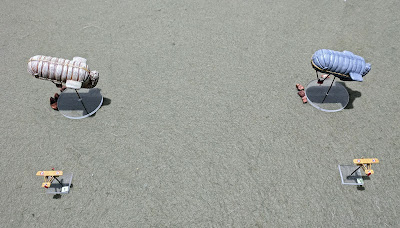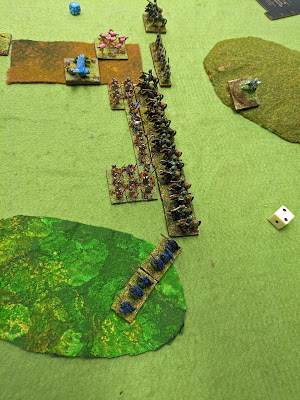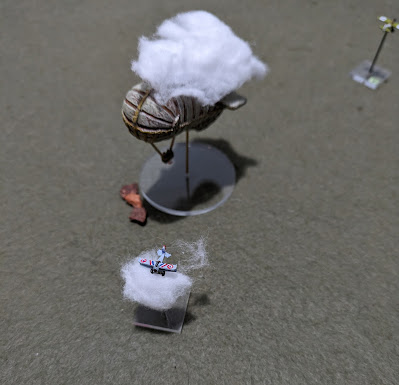I have been browsing a lot of thread on the Wings of War Forum as, whilst they relate to a specific game, a lot of the discussion covers general WW1 air subjects and it's fairly easy to relate them to my own rules. As you know I painted a kite balloon last week, and this week I did its companion:
It coincided with reading
THIS THREAD on the forum, looking at what would be important in games involving shooting down balloons. I tried to organise some rules based on them in order to add such attacks to my S&L games.
The rules I needed to add were for anti-aircraft fire, shooting at balloons and, additionally, shooting at balloons with Le Prieur rockets or with incendiary ammunition. Today I tried out some of these ideas.
I set my first game in the Summer of 1915. The British were having a crack at a couple of German balloons using a pair of Vickers FB5s. They would be relying on their machine-guns to try and down the balloons.
They both closed on on the southern balloon (the grey one).
The anti-aircraft fire began. If a plane was within 6" of a balloon it would be subject to AA fire, which took place before regular shooting. This would consist of a 2 dice attack on the aircraft, with a 6 scoring a hit. Criticals are tested as normal, but structural hits score an additional 1D6 damage. Any plane with 2" of a balloon, or friendly aircraft would only be attacked by a 1D6 shot. But, yes - AA fire affects friendly aircraft.
One Vickers took a direct AA hit and was blown to pieces.
The surviving Vickers pressed home its attack, opening up on the balloon. I ran firing against a balloon as normal combat, although the +1D6 modifier for a large target applied. Deflection modifiers do not apply. A balloon can take 24 hits; a single plane is unlikely to achieve this, although criticals are tested for as normal, with crew hits affecting the observer in the basket, and engine hits of either kind counting as instant destruction. Regardless of criticals, after an attack that scores any hits the attacking aircraft rolls 2D6 and takes the highest score. If the score is equal to or less than the number of hits inflicted in the attack then the balloon catches fire, and is considered destroyed. The odds of this happening are low, as the Vickers soon found out.
The Germans had one Fokker Eindecker on patrol as well. On each turn I rolled a D6 and on a 6 it turned up, on a random side edge, in line with the balloons. It turned up as the Vickers made its first attack.
The Vickers turned behind the balloon as the Fokker fired a long-range burst at it.
The Vickers briefly evaded the Fokker.
Rather than turn slowly back on the grey balloon, the Vickers went after the khaki balloon instead, whilst the Fokker turned to attack it again.
Disaster for the Germans as the Fokker took a direct AA hit and dropped from the sky, its pilot dead.
The Vickers closed on the balloon, shooting as it went. It scored hits, but couldn't get an ignition.
What are those red markers next to the balloon? Well, they represent its 'altitude'. Any time there is an enemy aircraft within 6" of the balloon its crew will attempt to winch it down to the ground. The technology for this progressed throughout the war, with the balloons being pulled down by hand at first, then teams of horses, then steam-engines and finally by petrol-driven winches. By the end of the war the balloon could be pulled down in minutes. My rules are as follows:
At the end of any turn in which a balloon has an enemy aircraft within 6", the crew will try and pull it down. Roll a D6; if the score for the year is achieved then one marker is removed. When all markers are removed then the balloon has reached the ground and can no longer be attacked. The rolls are:
1914-15 - 6, 1916 - 5+, 1917 - 4+, 1918 - 3+
(I am considering making the AA attacks within 6" of the balloon 3D6 if it is at two markers or fewer, to simulate the attacking aircraft having to fly lower.)
Anyway, in this scenario the balloon is only lowered on a 6 each turn, so the Vickers had plenty of time to make attacks. Unfortunately none of them caused the balloon to catch fire, and the Vickers eventually ran out of ammunition and headed for home.
A final burst of AA fire saw no damage, and the Vickers got back, mostly intact.
So in terms of dropping a balloon the mission had been a failure, with the loss of one of the attacking aircraft. The only bright spot was the loss of the German plane, but that was an own-goal, so hardly a cause for celebration.
So balloon busting with machine-guns is not the best way to ensure success.
I tried again, but this time shifted to the Summer of 1916. This time the French were attacking, with a pair of Nieuport 16s, fitted with Le Prieur rockets. The Germans could test to bring on two Fokker Eindeckers.
Everything you'd ever want to know about Le Prieur rockets is
in this excellent paper, that was linked to on the Wings of Glory Forum. The key thing is that they have a short range and are best used against the wind. The nose of the balloon faces into the wind, so you really need to get behind it to be effective. I used the following rules to check the direction of the balloons:
They start the game facing the Allied baseline (the west, from which the prevailing wind blows). I then rolled 4D6. each 1 or 2 rotates the balloons 45 degrees anticlockwise. Each 5 or 6 rotates them 45 degrees clockwise. Obviously each roll of 1 or 2 negates a roll of 5 or 6 (and vice versa). In this game they turned 45 degrees clockwise (facing the north west). British or French balloons would have their rear facing the German lines, but the Germans never used rockets, so it's not really an issue.
Anyway, with no German aircraft around the Nieuports split up, each going after a balloon.
Of course, just after the did this a Fokker turned up.
AA fire exploded around both aircraft as the Fokker closed in on one of the Nieuports.
The other Nieuport also found it was receiving a lot of attention from ground fire.
One burst damaged its engine, but it kept up the attack.
Rockets fire at close range only (up to 3"). They are treated as normal gunnery, but get the deflection modifiers for shooting into the balloon's front or rear arc. A plane has two volleys of rockets; you can fire one of them or both. A single volleys hits on a 5+. A double volley hits on 4+. When testing for ignition you take the lower of the two dice rolled. It's a lot easier to kill a balloon with rockets.
Boom! The first Nieuport ignited the balloon, destroying it.
The other Nieuport also hit and destroyed its balloon. However as it flew bast the burning Drachen it was hit by AA fire and destroyed.
The first Nieuport was slightly damaged by its exploding balloon. I ruled that the turn after a balloon ignited, it would explode, and any plane within 2" would take a 3D6 AA fire attack. With its damaged engine it didn't have the speed to escape the explosion.
The surviving Nieuport now had to get home. Both Fokkers were in play, with one closing in on the Nieuport's rear and the other moving to cut it off.
The Nieuport slowly edge in behind the one Fokker, but soon found the second Fokker on its tail.
It started to take hits.
It tried to inflict hits on the Fokker in front of it, but its shooting was abysmal.
The lead Fokker broke away, but the other Fokker stuck doggedly to the tail of the little French plane.
Both Fokkers now attacked, and the Nieuport went down.
So the French got both balloons but lost both attacking aircraft. I'd probably count that as a minor victory for the French, but nothing more.
So thoughts for future games. I'm still working out how to score the games. Destroying a balloon should get good points, and the attackers should lose points for lost planes. Shooting down defending planes might give a point as well, but isn't the aim of the mission. Killing or wounding the observer on a balloon that isn't destroyed should give a few points too, as it puts the observation platform out of action for a period. And if the balloon reaches the ground that should give the attacker points as well, since, again, it deprives the defenders of the balloon's use for a while whilst it is got back into action.
I'm still trying to work out just how effective rockets were. I may drop the hit chances to a 6 for a single volley and 5+ for the double volley. They get good odds of converting hits to a burn, but I like the idea that actually scoring a hit is hard. Obviously attacking from the optimal tail position maximises hits.
I may have balloons roll to see if they explode once they are on fire, so you don't know exactly when they will go up. Setting them on fire is a kill; that is for sure. But since they are dangerous when they explode it's fun to make that random. I think maybe a 4+ on each turn, including the fire phase when they are set on fire (so if you've attacked them at close range there's a 50% chance you'll risk taking damage from it). Then you test each fire phase just before you resolve AA fire.
I haven't tried incendiary ammunition yet. This would use the normal gunfire rules, but with the ignition test being on the lowest of the two dice. In theory it wasn't supposed to be used on enemy aircraft, but was. I'm not sure what effects to apply there, though.
Anyway, that was a long report, with a lot of rules mixed in, many of which are to remind me how I played the game in case I lose my scribbled notes. But I hope they give an indication as to my thought-processes when setting up the game.








































































